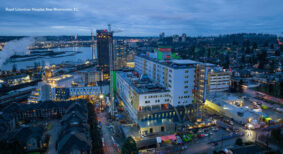Durable roof design is accomplished by the selection of proven high-performance materials, detailed to accepted standards and assembled by skilled tradespeople. If one of the three parts fail, the roof can fail prematurely and/or perform poorly. With sound design following the dual barrier theory, defects in workmanship and material operation can have a reduced impact on the roofs performance.
Waterproofing systems or roofing membranes within the roof assembly are generally the only barrier to keep the elements out. This is unlike other building components such as windows or walls. Standard building cladding design recognizes a good performing wall consists of layers of materials or zones to resist wind, heat and rain, among other elements.
Protected membrane roof (PMR) assemblies can provide superior performance over conventional exposed roof membranes since the membrane is protected by insulation and ballast from mechanical damage, ultraviolet rays and thermal cycling.
Drawbacks of the traditional PMR include restrictions to positive drainage and increased dead load to the structure. The water that collects and drains over the PMR (under the insulation) can decrease the service life of the roof membrane. The flow of water also reduces the effectiveness of the insulation.
Including the theory of “dual barrier” design can help manage some weaknesses of the traditional PMR. But while the concepts for dual barrier designs have been common with wall systems, they are less recognized with roof systems. Common uses of dual barrier wall systems include two stage cladding sealant joints, compartmentalized window frames and rain screen walls. Roof systems over podium decks function as dual barrier PMR where the majority of water drains over hard or soft landscaping to bi-level drains. Any water that reaches the primary roof membrane is allowed to drain at the lower level of the bi-level drain.
Dual barrier roofing can be incorporated by adding new layers to further improve the performance of a protected roof assembly. The “dual barrier” or “rain screen” PMR has multiple water resistance planes to improve leakage resistance. The placement of these additional water resistance planes can vary depending on the roof. Typically, PMRs utilize the additional layer(s) of material above the insulation to act as an additional drainage layer. While this layer above the insulation is not the primary waterproofing component of the PMR, it does act as the first component to shed bulk water to the drains. Typical PMRs consist of (from the top down) ballast, ballast reducing fabric, moisture resistant insulation (extruded polystyrene), roof membrane and structural roof deck . Selecting ballast reducing fabrics that shed water will change a typical PMR to a dual barrier system. This can be done with minimal effect on the material and labour cost of the PMR.
Simply described, a dual barrier system is a protected membrane roof assembly that has a primary roof membrane that is the principal plane of air and water tightness but also incorporates a secondary layer that can function as the first water shedding layer. This layer can also be designed to better separate the ballast from the insulation and membrane below, reduce air movement under the insulation and provide water retention above the insulation.
The benefits of the typical PMR can improve the roof’s performance over most conventional roof assemblies. PMR dual barrier systems can further improve the roof’s performance to address variables in the materials and how they get installed. Leak prevention is enhanced by dual barrier roofs but additional benefits can include: increased/extended membrane performance; improved thermal effectiveness of the insulation; cost-effective renewal opportunities; reduced maintenance costs; and improved life cycle costing.
PMR dual barrier roofs increase roof performance over typical PMRs. The redundancy in the roof’s performance will help protect the building manager’s key roofing asset at a minimal cost. This approach is equally valid in new construction and retrofits, and owners appreciate the added value at a minor incremental capital premium.
Torsten Ball is a senior project manager at Halsall Associates, a national building engineering firm that provides consulting services for new and existing buildings. He is a member of Halsall’s facility services department and one of Canada’s first designated green roof professional consultants.










Nice read on Dual Barrier roofs.